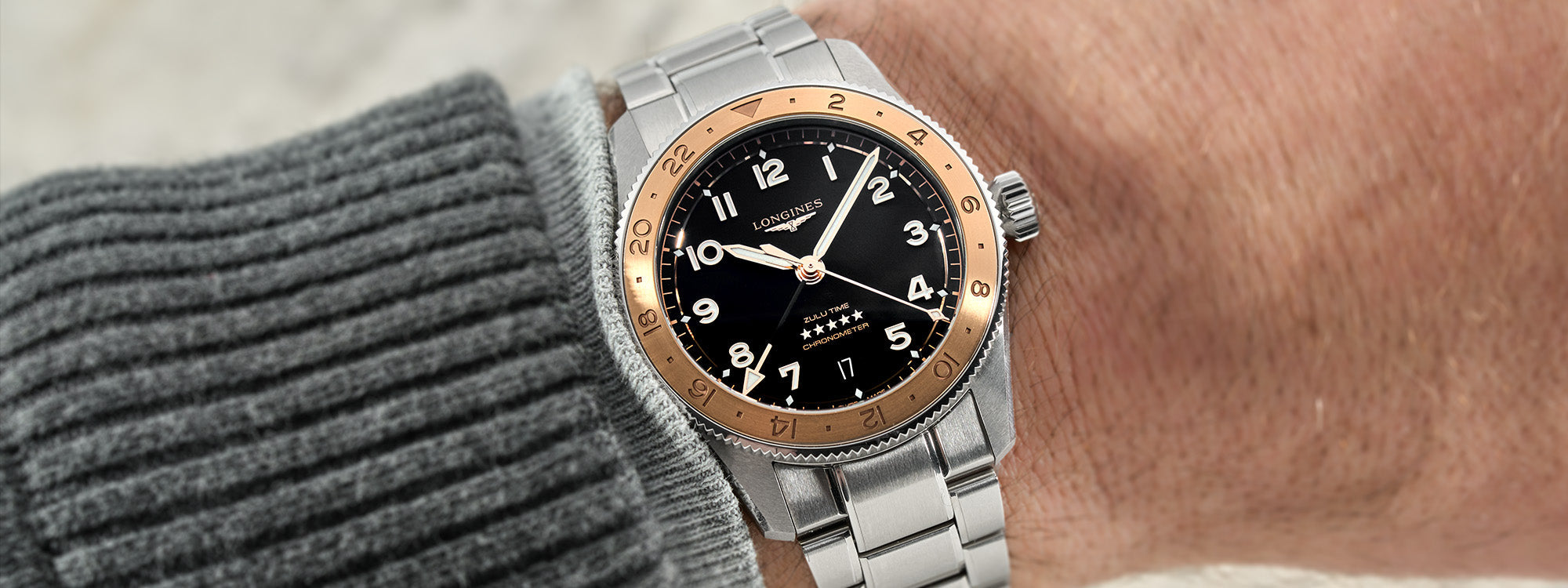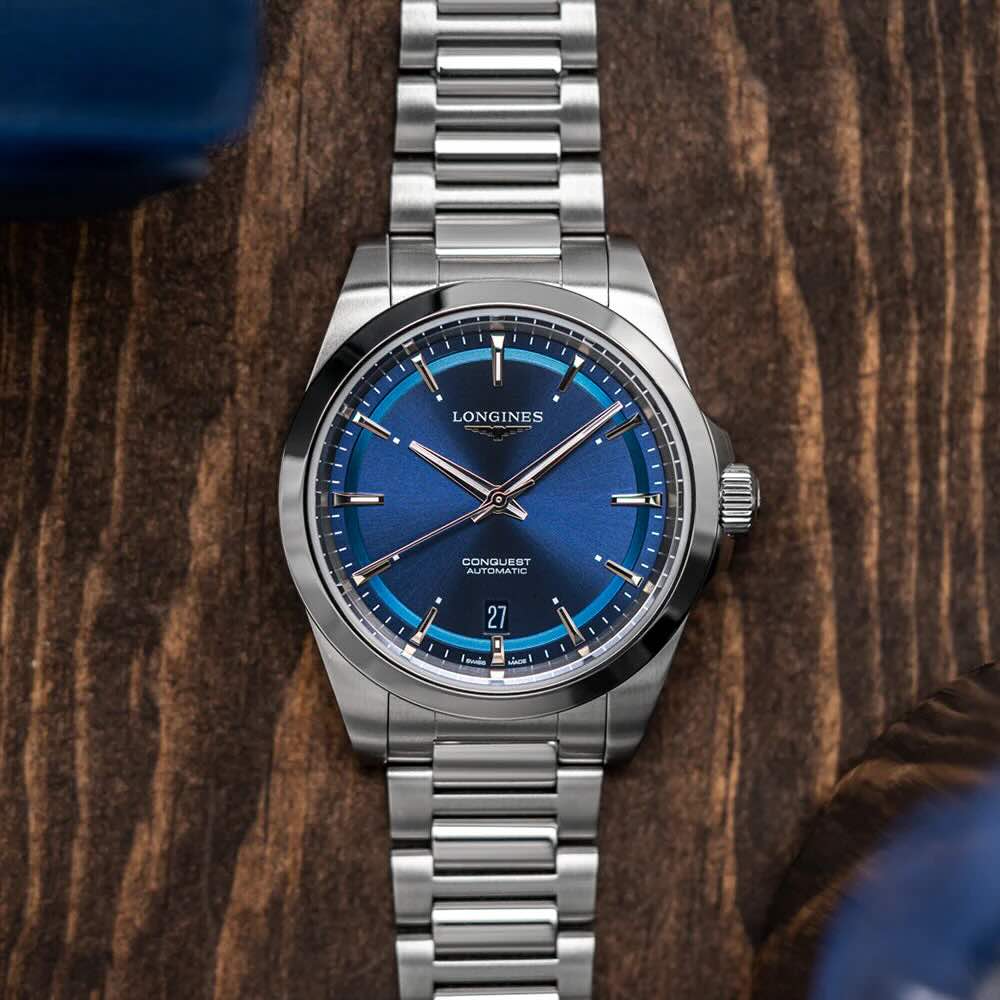Longines introduced the Zulu Time models to its aviation-influenced Spirit collection in 2022, and the watch’s dual-time complication, stylishly bold design, and undeniable value proposition have made it one of the brand’s biggest hits of the 2020s, spawning additional models in an array of sizes, materials, and color executions. The Spirit Zulu Time is now such a fixture in the Longines portfolio that it almost seems like it has always been there, despite being a relatively recent addition to the lineup; it doesn’t even precede the Covid pandemic, which, of course, somehow seems like it happened only yesterday and yet also in another time and dimension entirely.


However, all of that said, Longines’ history of making dual-time or GMT wristwatches like the Zulu Time reaches back much further — 100 years, to be exact. And it is that century milestone to which Longines pays tribute with the latest member of the family, unveiled today: the Longines Spirit Zulu Time 1925.
Longines Zulu Time History:

Longines produced its first “Zulu Time” wristwatch in that eponymous year of 1925, in the heart of the Art Deco era. Very dissimilar to the round-cased modern descendant, that watch had an angular, square case and ornate hour numerals, along with a third hand to indicate a second time zone and, most notably, a Zulu flag emblem with a red letter “Z.” Where did this iconography originate? In military jargon, “Zulu” is the radio transmission articulation for the letter “Z” (like “Alpha” for A, “Tango” for T, etc.) and the letter “Z” is used to Greenwich Mean Time, based on the longitudinal line in Greenwich, England, that separates the Eastern and Western Hemispheres.

Essentially, Zulu Time means the same thing as GMT (Greenwich Mean Time) or the more modern term, UTC (Universal Time Coordinated. (Both GMT and UTC are used more commonly these days in naming watches with a dual-time function.) That 1925 piece was the first wristwatch that was designed to display two time zones simultaneously, but it was not the first watch of any kind to attempt this feat; Longines itself had been dabbling in that area since as early as 1908, with a pocket watch custom-made for a client in the Ottoman Empire that could indicate the time in France and the owner’s native Turkey simultaneously.
Longines Spirit Zulu Time 1925 Case:

The Spirit Zulu Time 1925 comes in the “sweet spot” 39mm size that Longines rolled out about a year after the original 42mm proved just a bit too big for some prospective owners. The case and bracelet are made from stainless steel, as on the majority of the core models (at least the ones that aren’t in titanium), but lent a distinctive air of celebratory luxury here with the addition of a bezel insert made of 18k rose gold with a circular brushed finish. This is a first for the Zulu Time collection, which primarily uses ceramic for these inserts.
 The bezel rotates in both directions, with its engraved numerals and indexes denote the 24 hours determined by Greenwich Mean Time to represent the world’s major time zones. These indicators on the bezel are used in coordination with the dial’s central, arrow-tipped GMT hand to read the time in another time zone. The use of a rose gold, which contains copper, serves a symbolic function as well as an aesthetic one: it’s a subtle homage to the copper strip that marks the Prime Meridian at the Royal Greenwich Observatory in England — which, of course, is where we get the phrase “Greenwich Mean Time” in the first place.
The bezel rotates in both directions, with its engraved numerals and indexes denote the 24 hours determined by Greenwich Mean Time to represent the world’s major time zones. These indicators on the bezel are used in coordination with the dial’s central, arrow-tipped GMT hand to read the time in another time zone. The use of a rose gold, which contains copper, serves a symbolic function as well as an aesthetic one: it’s a subtle homage to the copper strip that marks the Prime Meridian at the Royal Greenwich Observatory in England — which, of course, is where we get the phrase “Greenwich Mean Time” in the first place.
Longines Spirit Zulu Time 1925 Dial:

The main hour and minute hands, along with the applied hour numerals, carry forward the gold tones of the bezel, contrasting boldly against the matte black dial. The applied Arabic hour numerals are also gilt-edged, and Super-LumiNova coats the insides of the numerals and the hands, as well as the tips of the seconds counter and the GMT hand. The venerable Longines winged hourglass logo appears in gold tone at 12 o’clock, balanced out by the five gold stars emblematic of the Spirit collection, along with “Zulu Time” and “Chronometer” in gilt text.


Directly beneath these elements, displacing the 6 o’clock numeral, is an elegantly faceted date window with white numerals on a black field. Also elegantly executed is the tone-on-tone “1925 - 2025” anniversary text, below the date display and following the curve of the gold-printed minute track between the 5 o’clock and 7 o’clock markers. From a functionality standpoint, the local-time hour hand is independently adjustable via the crown's second pulled-out position, enabling easy switching of time zones while the GMT (Okay, "Zulu") hand remains in place to indicate the time at home.
Caliber L844.4 Movement:

Another element that marks the Longines Spirit Zulu Time 1925 edition as special is the use of a sapphire viewing window in the caseback for a view of the movement, Longines’ Caliber L844.4 — rather than the solid, screwed caseback, which speaks to the watch’s globetrotting mission statement with an engraved globe meridian motif — found on the models in the regular collection. On this version of the movement, which is based on the automatic ETA A31.L411 sourced from Longines’ sister firm in the Swatch Group, the rotor has the same golden treatment as the bezel and dial elements, with a sun-brushed surface and an on-theme world-map rendering. (It’s not made clear whether the rotor itself is solid gold.) Also in plain view is the balance wheel oscillating at 25,200 vph and the perlage treatment on the plates and bridges.
Made of gold or not, that rotor supplies the movement a power reserve of 72 hours, or three days. (For those counting, that’s an improvement over the 64 hours of the base caliber, possibly owing to this one’s use of a friction-resistant silicon balance spring.) In its most recent updates to the movement, Longines has made two other key components out of antimagnetic material, ensuring that the watch meets the ISO764 standard for resistance to magnetic fields from 600 to 800 gauss. Significantly, the movement is also certified by the Swiss testing agency COSC for chronometric performance — the bragging rights which the five golden stars on the dial were established to represent.
Final Thoughts:

The Longines Spirit Zulu Time 1925 is mounted on a stainless steel three-link bracelet with the same sleek finishing as the case. Tapering slightly from its 21mm lug width, it fastens to the wrist securely with a double safety-folding clasp, which features an etched Longines logo and a user-friendly push-button release. The bracelet also features an easy-change mechanism that allows the wearer to swap out the bracelet for a black nylon NATO strap, which is included, without a tool. Available now, the watch carries a retail price of $4,350 — higher than the $3,300 fee for the steel versions of the 39mm Zulu Time, but slightly lower in price than the all-titanium version, which goes for $4,500.






















































0 Comments